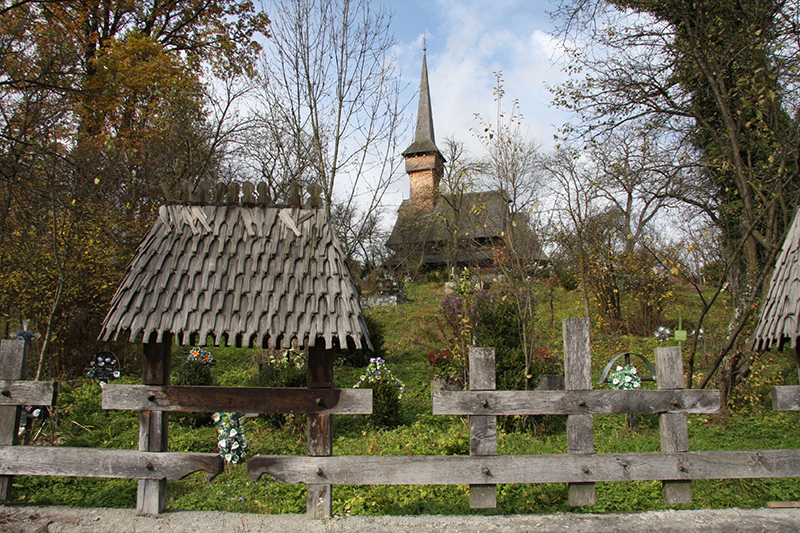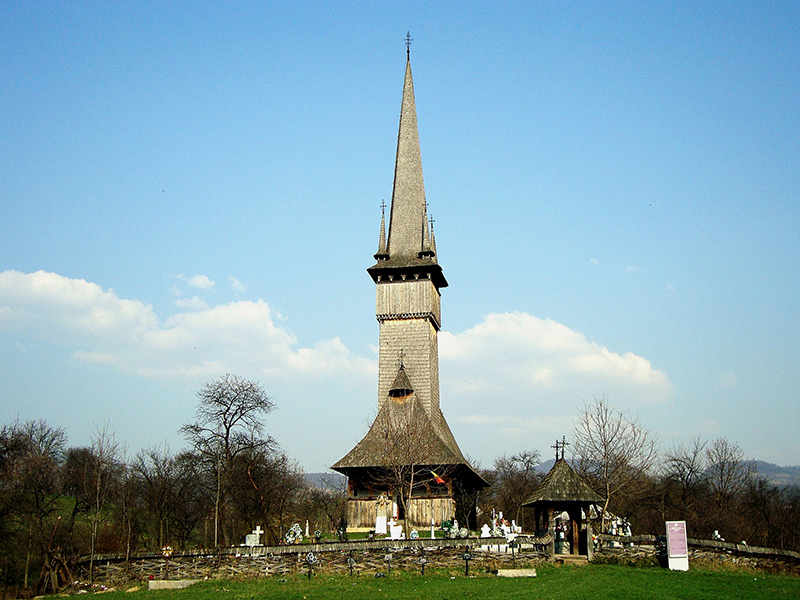The Wooden Churches of Maramures
UNESCO Sites
Maramureș is perhaps one of the most authentic regions in Romania, filled with a rich historical heritage, especially when it comes to traditional crafts. Exploring Maramures will reveal countless well-preserved wooden churches, houses with beautifully carved wooden gates, and cheerful locals dressed in traditional colorful clothes.
The building of wooden churches began in the 16th century when the Catholic Austro-Hungarian authorities prohibited the construction of Orthodox stone churches in the area. Initially, there were over 300 wooden churches built in the region, but today only around 100 are left standing. Most of them are Orthodox, but there are also some Greek-Catholic churches, and they greatly vary in terms of architectural style.
The wooden churches are built with high timber, and their most characteristic features are the tall and slim bell towers located at the western end of the building, as well as their massive roof that makes the whole main body look minuscule.
Inside, the churches are painted with biblical scenes by local painters, and many of them remained in great condition thanks to the local craftsmen and carpenters who constantly tend to them.
Out of the approximately 100 wooden churches, 8 of them were included in the list of UNESCO World Heritage Sites in Romania.
1. The wooden church of Barsana
3. The wooden church of Desesti
5. The wooden church of Plopis
Wooden Church of Barsana
Officially known as the Church of the Presentation of the Virgin in the Temple, this wooden church was built in 1720 and it got the name of Bârsana from the commune that it is located in. The church features some of the most representative baroque indoor murals, its walls depicting various scenes from the Apocalypse or the Last Judgement.
First mentioned in documents from 1326, the wooden church is one of the tallest wooden churches in Romania with 57 m height, and has been built alongside other churches by craftsmen from Maramures.

Barsana Church
Despite being built in 1720, the church was moved on the nearby Jbar Hill in 1806. According to a legend, this hill served as a graveyard for plague victims, and the dead were buried in a rush, without proper religious ceremony.
Thus, in order to calm the spirits, the locals decided to move the church on the burying grounds.
Budesti Josani Church
The Budești Church was built in the name of St. Nicholas in 1643, and it was made entirely out of oak. The main tower of the church has a height of 26 meters, and it is surrounded by 4 smaller towers that are built in a Gothic architectural style.
The church has an over raised interior space that is manifested outside in two waters. The monument impresses by its massiveness, being almost kept as the original construction with all its form and material. The church is made out of three important parts: the pronaus, the nave, and the altar. The interior has not changed a lot except some little changes that have been made in1922 that affected some of the mural paintings.

Budești Josani Church
Inside the church, you can find the chain mail of Pintea Viteazul, a legendary outlaw from Maramureș, somewhat similar to Robin Hood. The Budești church is also home to numerous painted wooden icons, as well as a large collection of painted glass icons, from the 15th - 17th century. In 1762 Alexander Ponehalschi painted the narthex, the nave, the iconostasis, and many other icons. In 1832, Ioan Opris painted the altar in the Baroque style.
Wooden Church of Desesti
Built in the village with the same name, the Desești Church dates back to 1770, and it is commonly known as the Pious Parascheva Church. The church follows the traditional Orthodox interior separation, with a narthex, a nave and an altar separated by an iconostas from the rest. With its representative steep rooftop with two eaves, the church has a more spacious interior than most of the other wooden churches.
The murals of the church were preserved in excellent condition, and they cover all of the walls of the church’s three bodies. This makes it one of the best examples of post-Byzantine paintings.with the rustic approach of Radu Munteanu’s work and the perfect lines of Alexander Ponehalschi. The nave paintings are the representations of the Old and New Testament. In the narthex, the paintings are representing the hell and heaven, with a dramatic intent to make everyone think about how their behavior is helping them or not in the afterlife.

Wooden Church of Desești
The church is also home to 14 stunning painted wooden icons, one of which dates back to the 17th century and depicts Jesus Pantocrator. The other paintings have been traced back to the 18th century.
Ieud Hill Church
Considered one of the oldest wooden churches in Europe, the Wooden Church of Ieud was built by a local noble family in 1628 and it is dedicated to the Nativity of the Virgin.
This small church that the locals call “the church on the hill” has the typical architectural style of the Maramureş Wooden Churches; its high tower is specific to the late Gothic architectural style, but it also bears significant Orthodox influences.

Ieud Hill Church
The amazing murals were made directly on wood by unknown artists and are very well-preserved even to this day.
Under the rooftop of this church, the codex of Ieud was found in 1921, featuring a very old writing in the Romanian language. Today, the codex is kept in the archives of the Romanian Academy in Bucharest.
Many researchers dated the manuscript to the 16th century, but others believe that it dates back to an even older period of 1391.
The Wooden Church of Plopiș
Dedicated to the Archangels Michael and Gabriel, the Plopiș Church was built between 1796 and 1798 by its villagers. The church was sanctified in 1811 on November 12th, and it had 49 founding families.
Later on, 49 coins were found hidden in the church, and it is believed that each coin was put there by one of the founding families.

The Wooden Church of Plopiș
Over the years, the church was restored numerous times – in 1901 it was repaired and it a balcony was added, in 1961 it was restored by the local authorities, in 1981 its walls were repainted, and between 1990 and 1991 it was restored for a final time.
The church only measures 17 m in length, 7 m in width and 47 m in height, but it impresses with its richness of decorations on the outside and the paintings and icons from the inside.
Poienile Izei Church
Commonly known as the Saint Parascheva Church, it was built in 1700 and it is considered one of the most beautiful wooden church of Maramureş.
The entrance gate of the church is like a portal through time, which takes you back in time and presents the life of the small community that lives here for hundreds of years ago.

Poienile Izei Church
Spectacular frescoes cover the interior of the church, with scenes of the Last Judgment being the dominating theme of the artwork. Some of the scenes depict images of terrible punishments for numerous sinners, such as a liar hanged by his tongue, a witch gored by cows for casting a spell on them, or a farmer that stole the land of his neighbor plowed by two devils.
The large depictions of the Hell, the impressive diversity of the sinners, and sometimes the violent punishment inflicted on the damned, demonstrate the emphasis on the moralizing and disciplinary functions which characterize the images of the Last Judgment in Maramureş.
This unrivaled monument, manifesting a high level of majestic art reached by the skilled carpenters of Maramures, can be considered without a doubt one of the most beautiful and well preserved wooden church in the Maramures county.
Rogoz Church
Also known as the Church of the Holy Archangels, the church is located in the village of Rogoz, in the valley of the Lăpuș River.
The church was constructed in 1633, and it withstood numerous Tatar invasions, mentioning in its inscriptions the Tatar invasion of 1717 as “the terrifying year 1717 of the time of the Tatars”.
In 1834 the size of the nave windows was increased, and in 1883 the church was moved to the center of the village.

Rogoz Church
The church is built almost completely out of timber, with only a couple of stone blocks and pebbles serving as a base for the construction. Its interiors are brightly painted with murals made by the same artists from the Desești Church, and they date back to 1785.
Surdesti Church
Just like the Plopiș Church, the Church of Surdești is dedicated to the Holy Archangels Michael and Gabriel, and it was built in 1766 by Ion Macarie.

Surdești Church
The Surdești Church amazes through its tall wooden tower, reaching a height of 54 meters, with a total height of 72 m, which makes it one of the tallest wooden constructions in Romania and in Europe. Besides its height, the church is also renowned for being the only church in the Land of Chioar with a double-eaved roof. The church itself is rectangular with a polygonal chancel apse.
Its interior was painted in 1783 by a local artist with biblical scenes from the New and Old Testament.
